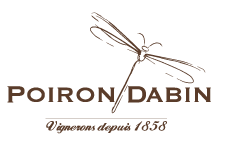The grapes are picked at full ripeness (we check the sugar-acidity balance into the grapes to know the date of harvest). Our grapes are picked by a latest-generation “Grégoire” harvesting machine. They are then taken to the cellars in stainless steel harvesting trailers. Here they are de-stalked and drained, then lightly pressed in a pneumatic press.
WHITE WINES

The juices flow into the reception vat and stay there for 48 hours; the must is then drawn off, leaving the deposit in the bottom of the vat (flesh deposit, which we filter to obtain a high-quality juice).
The clear juices are transferred to the vinification vat; fermentation is triggered naturally. To preserve the aromas, we keep temperatures below 20 ° C. Fermentation lasts from 3 to 4 weeks.
The wine will rest on these lees (yeast deposits after fermentation) for up to 14 months (maximum allowed period for using the wording “sur lie” (on the lees) ) and even longer for outstanding wines (Grande Réserve). This method gives to the wine body, complexity and volume on the palate.
ROSE WINES

Few rosés are made with a long maceration. However, as the pinot gris grape is not very coloured, it has to ferment for a week in a vat, such as a red wine, with controlled temperatures (10 °C). It is then pressed and goes through the same vinification process as the white wines.
RED WINES

The grapes are left into the vat for at least two weeks to undergo the alcoholic fermentation. Then, we remove them from the vat and press the marc. The wine we obtain is poured into barrels or vats. A second fermentation begins: the malolactic fermentation. This turns malic acid into lactic acid (twice less acidic gustatory speaking).
We draw the wine off, add sulphites and keep the vats and barrels topped up until bottling.
